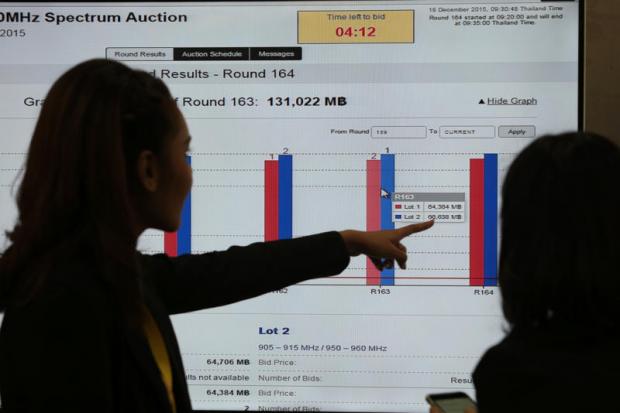
The National Broadcasting and Telecommunications Commission (NBTC) plans to allocate 380 megahertz of downlink and uplink slots through four spectrum ranges by 2020 to develop the digital infrastructure landscape.
The four ranges are 2600MHz, 1800MHz, 850MHz and 700MHz.
NBTC secretary-general Takorn Tantasith said the telecom regulator has to allocate more spectrum to ensure digital service and prevent a spectrum resource shortage for communication connectivity.
"Usage of mobile data service last year averaged 0.14 gigabytes per subscriber per day, or 4.11GB per subscriber per month," he said.
According to an NBTC report, data service usage in the country grew sixfold between 2014 to 2017 to three terabytes.
Mr Takorn said the figures reflect the popularity of mobile broadband internet for a variety of purposes after the 3G and 4G licence auctions in 2012 and 2015.
The 3G and 4G network roll-out nationwide by major mobile operators has boosted the bandwidth capacity of mobile networks, serving exponential demand growth for data service over the past four years.
Increased capacity has also driven social media usage in the country, with Line and Facebook having 42 million and 40 million users, respectively.
According to the NBTC report, there were 121.53 million mobile subscriptions last year, 53.05 million operated by Advanced Info Service (AIS) or 43.7% of the market, followed by 36.05 million True Move users or 29.6% of the market, and 30 million subscriptions operated by Total Access Communication (DTAC) or 24.7%.
State-run CAT Telecom had 2.32 million mobile service users last year or 1.9% of the market, and TOT had 0.11 million users or 0.1%.
Dividing into voice and data service usage, the report said mobile subscribers in the country last year used voice service via handsets, on average, two minutes per subscriber per day, declining from four minutes in 2014.
Voice service usage length for the overall market declined between 2014 and 2017.
Some 70.72 billion minutes in usage were logged in 2014, 62.8 billion minutes in 2015, 51 billion minutes in 2016 and 43.4 billion minutes in 2017.
In terms of quantity, AIS is the voice service leader, followed by DTAC and True Move.
The data service usage via mobile service in the country last year was, on average, 0.14GB per subscriber per day, or 4.11GB per month.
5G technology can provide up to 100 times faster data rates than 4G, creating opportunities for new-use cases for the Internet of Things, augmented reality and virtual reality applications, smart vehicles, remote healthcare, and robotics.
Mr Takorn said the regulator plans to allocate a total of 380MHz of downlink and uplink slots through four spectrum ranges by 2020, helping fulfil development of the digital infrastructure landscape and serving the Thailand 4.0 policy.
The 380MHz bandwidth for four spectrum ranges includes 180MHz of bandwidth on the 2600MHz spectrum, 90MHz of bandwidth on the 1800MHz spectrum and 20MHz of bandwidth on the 850MHz spectrum, as well as another 9MHz of bandwidth on the 700MHz spectrum.